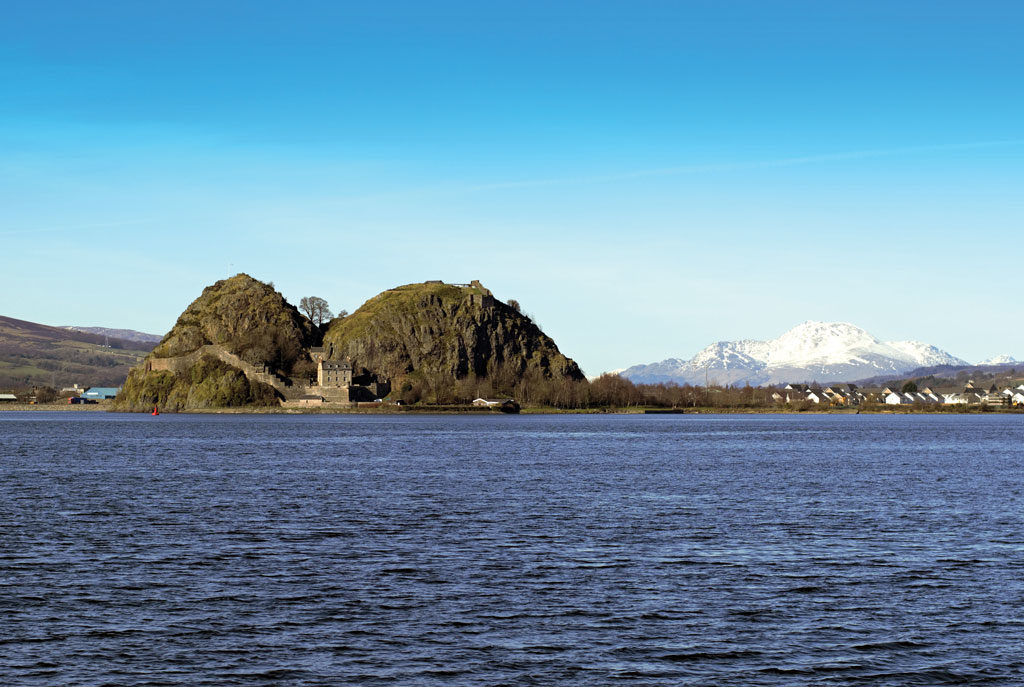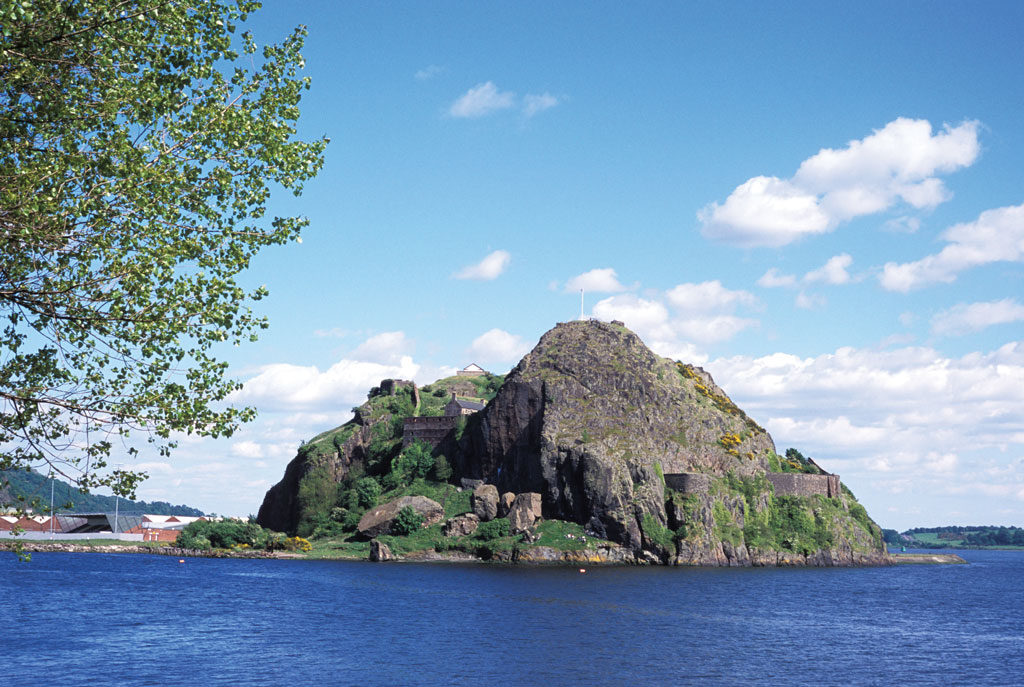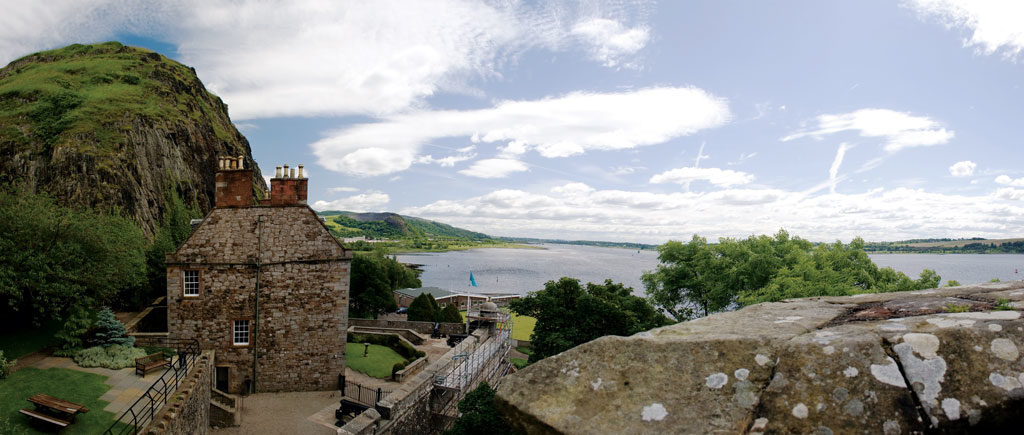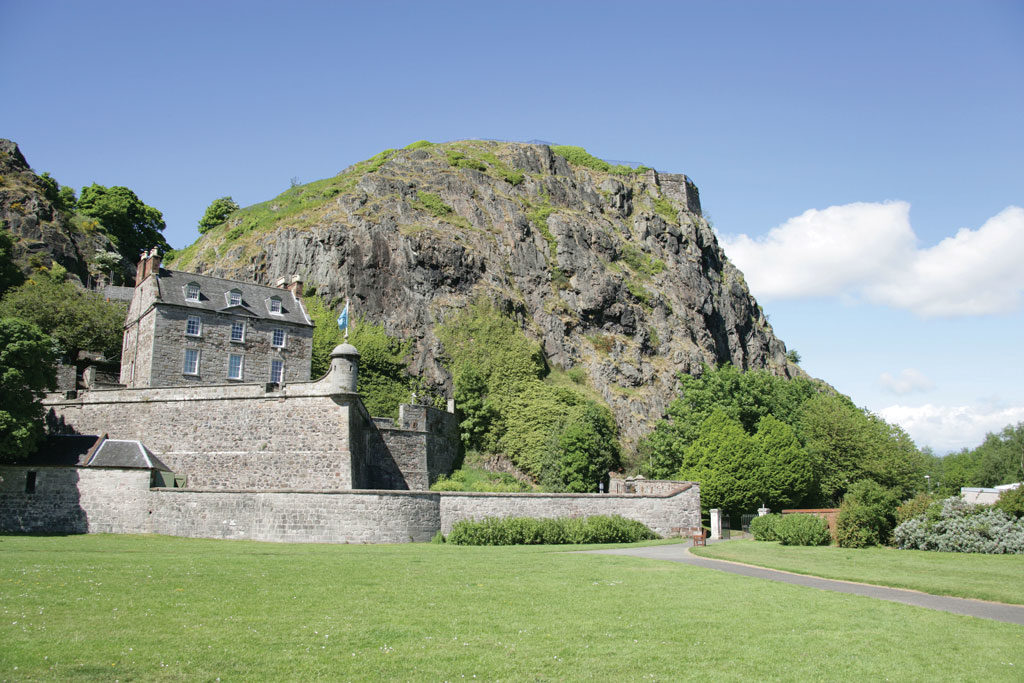Charles Douglas explores the history of Dumbarton Castle from Roman occupation to present day.
MORE FROM SCOTLAND MAGAZINE
Long ago there was a medieval Kingdom of Strathclyde that encompassed most of southern Scotland and northern England. It was centred on Alt Clut, the “Rock of the Clyde” – where Dumbarton Castle still stands today. Writing in AD731, the Venerable Bede refers to a fortified British City on the River Clyde and the burning of the Clyde Rock by the Picts and Northumbrians appears in records from AD780. Remnants of Roman-British pottery have been unearthed by archaeologists here, too.

From this we learn that a strategically positioned fortification on the northern shore of the River Clyde has existed since before the Romans abandoned their Caledonian conquests in the 5th century. Squatting on a volcanic plug of basalt claiming a provenance of 334 million years, a settlement has certainly been here since the Iron Age. Merging into Arthurian legend, it is even claimed that Merlin the Magician was in residence at some point during the 6th century. The chosen spot for the fortification, such as it then was and is now, lies between two twin peaks known as White Tower Crag and The Beak.
Over the passage of time, Scots, Vikings, Northumbrians and Picts laid siege to Dumbarton. The latter invasion was led by Ivar Ragnarsson, also known as “Ivar the Boneless”, who sailed his ships up the Clyde on his way to capture York. At much the same time, Olaf the White, King of Dublin, arrived from Ireland and carried off the castle occupants as slaves in a fleet of 200 longboats. Imagine how terrifying it must have been for the defenders to witness this flotilla approaching from the sea.

After its destruction during that invasion, Dùn Breatainn, the “Fortress of the Britons”, fell silent through the Dark Ages of history until the arrival of Alexander II around 1220. In 1305, Sir John Menteith of Ruskie and Knapdale, appointed Warden of the Castle, Town and Sheriffdom of Dumbarton a year earlier, is on record for capturing the renegade Sir William Wallace and for handing him over to the English for trial and execution.
King David II retreated here with Queen Joan on their way to France after his defeat at Halidon Hill in 1333. In 1425, the re-fortified Dumbarton Castle was attacked by James Mor Stewart, known as James the Fat, son of Murdoch Stewart, Duke of Albany, who had been accused of treason. The rebels were unable to take the castle which was staunchly held for King James I by Sir John Colquhoun of Luss.
Supporters of James’s grandson met here under the leadership of the 2nd Earl of Lennox in October 1489 and, after he ascended the Scottish throne, James IV took up occupancy, using it as the base for his navy during his attempt to subdue the Western Isles. Following the Battle of Flodden in 1514, Dumbarton Castle was captured by the 3rd Earl of Lennox who allegedly burrowed under North Gate under cover of a stormy night to gain entry.
The Stewarts continued to make use of their stronghold on Dumbarton Rock throughout the 16th century. James V used it as a prison and arrived in 1540 for a visit accompanied by the earls of Huntly and Arran, and Cardinal Beaton.
READ MORE: Clan Stewart History
Treachery, intrigue and betrayal was to prevail increasingly throughout Scotland and Dumbarton Castle under the Lennox family. In 1544, Matthew Stewart, 4th Earl of Lennox, married Lady Margaret Douglas, a daughter of Margaret Tudor, sister of Henry VIII of England and the Dowager Queen of Scotland. However, his rival in precedence to the Scottish throne was James Hamilton, 2nd Earl of Arran, the grandson of the eldest daughter of James II, and much hostility existed between the two men.
After the death of James V, the Regent Arran took control and during the period known as the Rough Wooing sent the infant Mary Queen of Scots to take up residence at the castle before being despatched to marry the Dauphin in August 1548. Arran accompanied the Queen to France.
The virtual civil war that embroiled Scotland following Mary’s return as monarch, and her second marriage to Lennox’s grandson, Lord Darnley, was complicated to say the least, dividing the nation after his murder and Mary’s ill-advised escapade with the 4th Earl of Bothwell – her third and final husband.

In 1568, Dumbarton Castle was fortified in support of Mary with stones removed from several demolished churches and houses in Dumbarton and Cardross. In April 1571, the castle was captured by the forces of Lennox, who had become Regent, on behalf of his grandson James VI.
In turn, Regent Morton was held as a prisoner here prior to his execution in 1581 for complicity in the murder of Darnley.
What visitors to Dumbarton Castle see today are the artillery fortifications that date from the 17th and 18th centuries. A replacement Wallace Tower was built to replace the previous medieval building. In 1644, the Scottish Parliament, encouraged by Oliver Cromwell, decided that the castle was likely to be more threatening than useful and its strategic importance declined after Cromwell’s death in 1658. That said, defences were again improved during the Jacobite Risings in the 18th century, and it was garrisoned in both the First and Second World Wars. In the latter, the German Luftwaffe dropped four bombs on the rock during a raid on Clydebank.
Still standing is the 16th century guard house in which there is the depiction of a face said to be that of “Fause Menteith”, the Sir John Menteith who betrayed Wallace. However, that legacy is somewhat softened by John having later been one of the negotiators of the truce between King Robert and the English, signed in 1323.

The Governor’s House was built as late as the 18th century for John Kennedy, 8th Earl of Cassilis, who held the office of Governor of Dumbarton Castle between 1737 and 1759. King George’s Battery, which dominates the Clyde side of the rock, was also built in 1735. The Magazine was built on The Beak in 1748 after earlier buildings had been demolished and it was specifically designed to resist artillery shells. However, visitors beware. There are 557 steep steps to climb to reach the White Tower Crag and other attractions.
As historic sites go, a visit to Dumbarton Castle is a fascinating experience, conjuring up three potent ages in the passage of Scotland’s turbulent history from Roman occupation through to the present day. From the riverside, it stands gaunt and defiant, a reminder that in Scotland the past is always inescapable.
Address: Dumbarton Castle, Castle Road, Dumbarton, G82 1JJ.
Opening times: 1 April to 30 September, 9.30am until 5.30pm; 1 October to 31 March: Daily except Thursdays and Fridays, 10am until 4pm. historicenvironment.scot
MORE FROM SCOTLAND MAGAZINE

SCOTLAND MAGAZINE
Published six times a year, every issue of Scotland showcases its stunning landscapes and natural beauty, and delves deep into Scottish history. From mysterious clans and famous Scots (both past and present), to the hidden histories of the country’s greatest castles and houses, Scotland‘s pages brim with the soul and secrets of the country.
Scotland magazine captures the spirit of this wild and wonderful nation, explores its history and heritage and recommends great places to visit, so you feel at home here, wherever you are in the world.